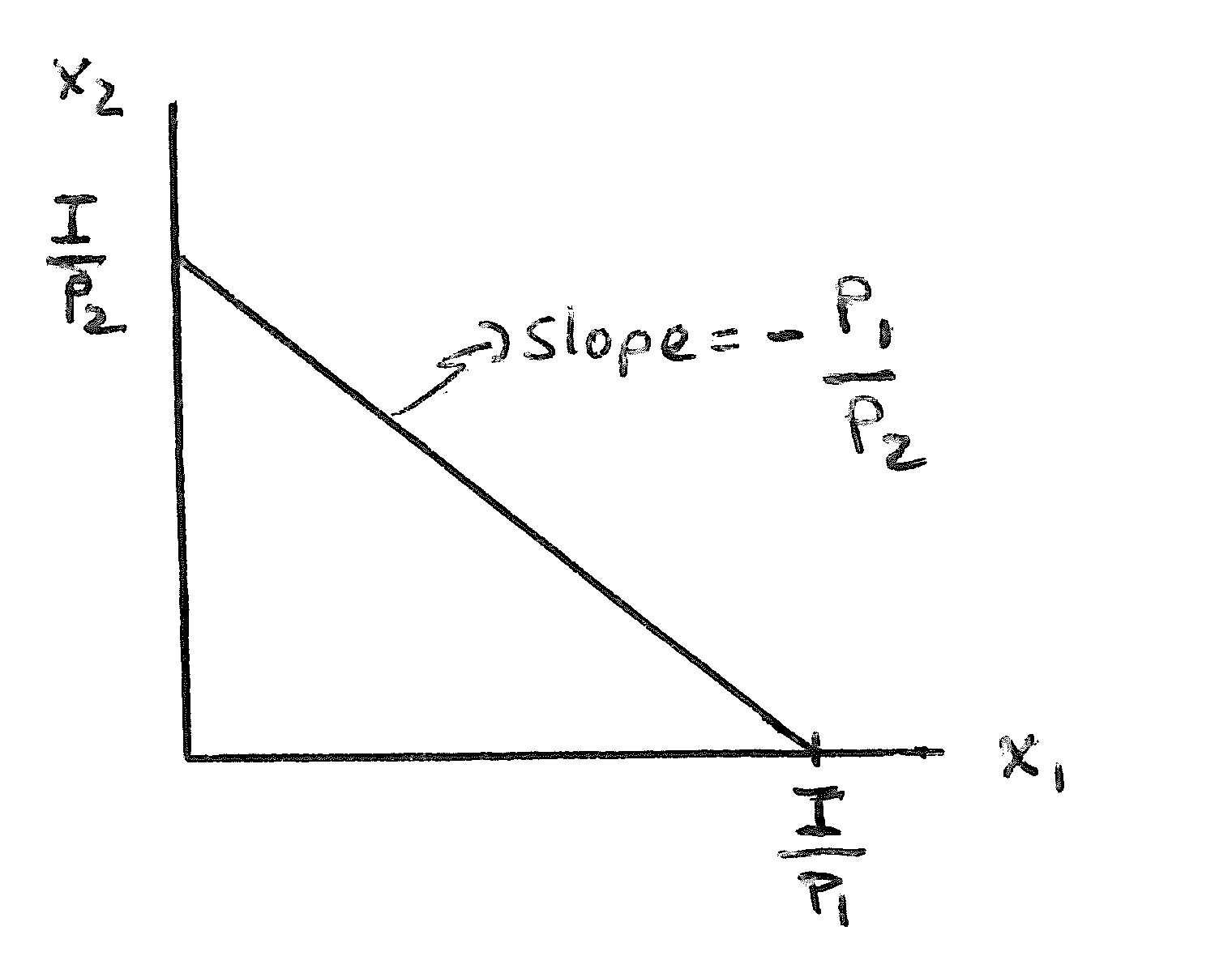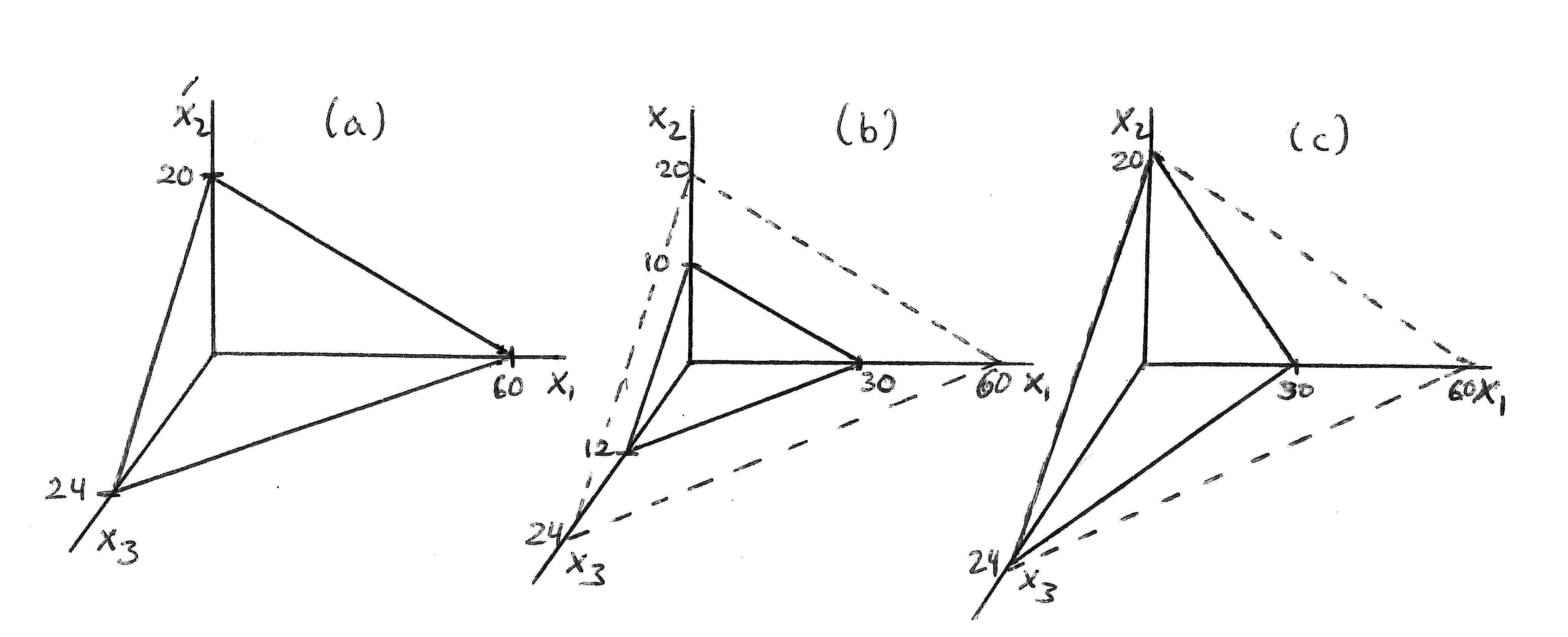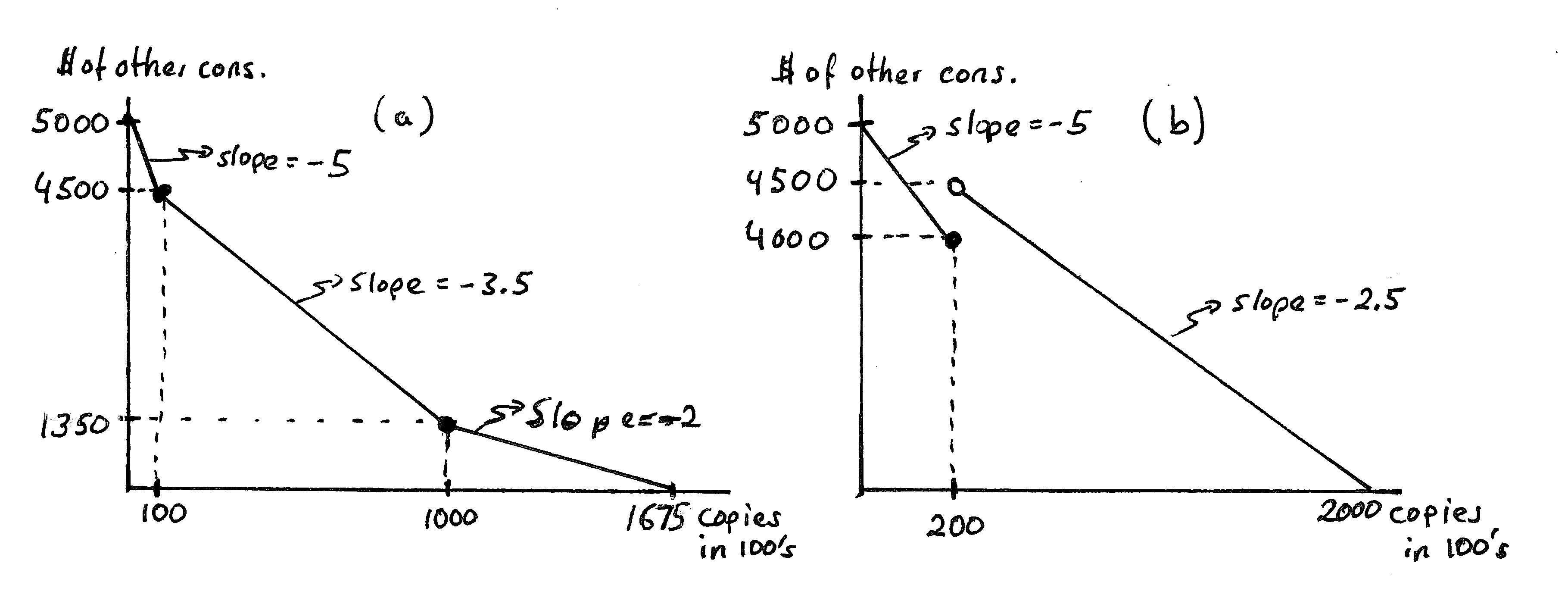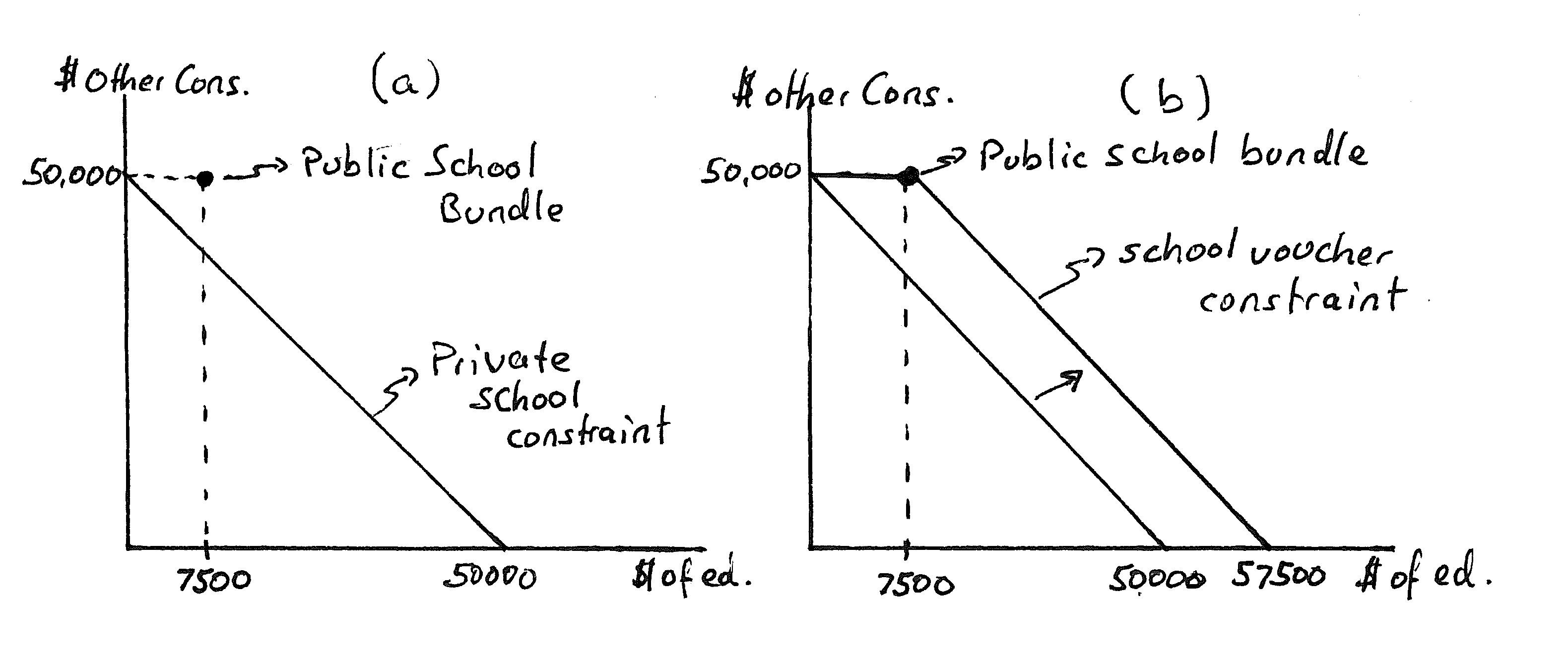
Microeconomics An Intuitive Approach with Calculus 2nd Edition Thomas Nechyba Solutions Manual Visit to Download in Full: https://testbankdeal.com/download/microeconomics-an-intui tive-approach-with-calculus-2nd-edition-thomas-nechyba-solutions-manual/
ChoiceSetsandBudgetConstraints
Theeven-numberedsolutionstoend-of-chapterexercisesareprovidedforuse byinstructors. (Solutionstoodd-numberedend-of-chapterexercisesareprovidedhereaswellasinthe StudyGuide thatisavailabletostudents.)
Solutionsmaybesharedbyaninstructorwithhisorherstudentsattheinstructor’sdiscretion.
Theymaynotbemadepubliclyavailable.
Ifpostedonacourseweb-site,thesitemustbepasswordprotectedandfor useonlybythestudentsinthecourse.
Reproductionand/ordistributionofthesolutionsbeyondclassroomuseis strictlyprohibited.
Inmostcolleges,itisaviolationofthestudenthonorcodeforastudentto sharesolutionstoproblemswithpeersthattakethesameclassatalaterdate.
•Eachend-of-chapterexercisebeginsonanewpage.Thisistofacilitatemaximumflexibilityforinstructorswhomaywishtoshareanswerstosomebut notallexerciseswiththeirstudents.
•IfyouareassigningonlytheA-partsofexercisesin Microeconomics:AnIntuitiveApproachwithCalculus,youmaywishtoinsteadusethesolutionset createdforthecompanionbook Microeconomics:AnIntuitiveApproach
• SolutionstoWithin-ChapterExercisesareprovidedinthestudent StudyGuide.
CHAPTER
2
Microeconomics An Intuitive Approach with Calculus 2nd Edition Thomas Nechyba Solutions Manual Visit TestBankDeal.com to get complete for all chapters
Exercise2.1
AnygoodSouthernbreakfastincludesgrits(whichmywifeloves)andbacon (whichIlove).Supposeweallocate$60perweektoconsumptionofgritsandbacon, thatgritscost$2perboxandbaconcosts$3perpackage.
A: Useagraphwithboxesofgritsonthehorizontalaxisandpackagesofbacon ontheverticaltoanswerthefollowing:
(a) Illustratemyfamily’sweeklybudgetconstraintandchoice set. Answer:Thegraphisdrawninpanel(a)ofExerciseGraph2.1.
ExerciseGraph2.1:(a)Answerto(a);(b)Answerto(c);(c)Answerto(d)
(b) Identifytheopportunitycostofbaconandgritsandrelatethesetoconcepts onyourgraph.

Answer:Theopportunitycostofgritsisequalto2/3ofapackageofbacon (whichisequaltothenegativeslopeofthebudgetsincegritsappearon thehorizontalaxis).Theopportunitycostofapackageofbaconis3/2of aboxofgrits(whichisequaltotheinverseofthenegativeslopeofthe budgetsincebaconappearsontheverticalaxis).
(c) Howwouldyourgraphchangeifasuddenappearanceofararehogdiseasecausedthepriceofbacontoriseto$6perpackage,andhowdoesthis changetheopportunitycostofbaconandgrits?
Answer:Thischangeisillustratedinpanel(b)ofExerciseGraph2.1.This changestheopportunitycostofgritsto1/3ofapackageofbacon,and itchangestheopportunitycostofbaconto3boxesofgrits.Thismakes sense:Baconisnow3timesasexpensiveasgrits—soyouhavetogive up3boxesofgritsforonepackageofbacon,or1/3ofapackage ofbacon for1boxofgrits.
(d) Whathappensinyourgraphif(insteadofthechangein(c))thelossofmy jobcausedustodecreaseourweeklybudgetforSouthernbreakfastsfrom $60to$30?Howdoesthischangetheopportunitycostofbacon andgrits?
ChoiceSetsandBudgetConstraints 2
ChoiceSetsandBudgetConstraints
Answer:Thechangeisillustratedinpanel(c)ofExerciseGraph2.1.Since relativepriceshavenotchanged,opportunitycostshavenotchanged. Thisisreflectedinthefactthattheslopestaysunchanged.
B: Inthefollowing,compareamathematicalapproachtothegraphicalapproachusedinpartA,usingx1 torepresentboxesofgritsandx2 torepresent packagesofbacon:
(a) Writedownthemathematicalformulationofthebudgetlineandchoice setandidentifyelementsinthebudgetequationthatcorrespondtokey featuresofyourgraphfrompart2.1A(a).
Answer:Thebudgetequationis p1 x1 + p2 x2 = I canalsobewrittenas
x2 = I p2 p1 p2 x1 (2.1.i)
With I = 60, p1 = 2and p2 = 3,thisbecomes x2 = 20 (2/3)x1 —anequationwithinterceptof20andslopeof 2/3asdrawninExerciseGraph 2.1(a).
(b) Howcanyouidentifytheopportunitycostofbaconandgritsinyourequationofabudgetline,andhowdoesthisrelatetoyouranswerin2.1A(b).
Answer:Theopportunitycostof x1 (grits)issimplythenegativeofthe slopeterm(intermsofunitsof x2).Theopportunitycostof x2 (bacon)is theinverseofthat.
(c) Illustratehowthebudgetlineequationchangesunderthescenarioof2.1A(c) andidentifythechangeinopportunitycosts.
Answer:Substitutingthenewprice p2 = 6intoequation(2.1.i),weget x2 = 10 (1/3)x1 —anequationwithinterceptof10andslopeof 1/3as depictedinpanel(b)ofExerciseGraph2.1.
(d) Repeat(c)forthescenarioin2.1A(d).
Answer:Substitutingthenewincome I = 30intoequation(2.1.i)(holdingpricesat p1 = 2and p2 = 3,weget x2 = 10 (2/3)x1 —anequation withinterceptof10andslopeof 2/3asdepictedinpanel(c)ofExercise Graph2.1.
3
Exercise2.2
Supposetheonlytwogoodsintheworldarepeanutbutterandjelly.
A: Youhavenoexogenousincomebutyoudoown6jarsofpeanutbutterand2 jarsofjelly.Thepriceofpeanutbutteris$4perjar,andthe priceofjellyis$6per jar.
(a) Onagraphwithjarsofpeanutbutteronthehorizontalandjarsofjellyon theverticalaxis,illustrateyourbudgetconstraint.
Answer:Thisisdepictedinpanel(a)ofExerciseGraph2.2.Thepoint E istheendowmentpointof2jarsofjellyand6jarsofpeanutbutter(PB). Ifyousoldyour2jarsofjelly(atapriceof$6perjar),youcouldmake $12,andwiththatyoucouldbuyanadditional3jarsofPB(attheprice of$4perjar).Thus,themostPByoucouldhaveis9,theinterceptonthe horizontalaxis.Similarly,youcouldsellyour6jarsofPBfor$24,andwith thatyoucouldbuy4additionaljarsofjellytogetyoutoamaximumtotal of6jarsofjelly—theinterceptontheverticalaxis.Theresultingbudget linehasslope 2/3,whichmakessensesincethepriceofPB($4)divided bythepriceofjelly($6)isinfact2/3.
ExerciseGraph2.2:(a)Answerto(a);(b)Answerto(b)

(b) Howdoesyourconstraintchangewhenthepriceofpeanutbutterincreases to$6?Howdoesthischangeyouropportunitycostofjelly?
Answer:Thechangeisillustratedinpanel(b)ofExerciseGraph2.2.Since youcanalwaysstillconsumeyourendowment E ,thenewbudgetmust contain E .Buttheopportunitycostshavenowchanged,withtheratioof thetwopricesnowequalto1.Thus,thenewbudgetconstraint hasslope 1andrunsthrough E .Theopportunitycostofjellyhasnowfallenfrom 3/2to1.Thisshouldmakesense:Before,PBwascheaperthanjellyand so,foreveryjarofjellyyouhadtogiveupmorethanajarofpeanutbutter.
ChoiceSetsandBudgetConstraints 4
ChoiceSetsandBudgetConstraints
Nowthattheyarethesameprice,youonlyhavetogiveuponejarofPB toget1jarofjelly.
B: Considerthesameeconomiccircumstancesdescribedin2.2A andusex1 to representjarsofpeanutbutterandx2 torepresentjarsofjelly.
(a) Writedowntheequationrepresentingthebudgetlineandrelatekeycomponentstoyourgraphfrom2.2A(a).
Answer:Thebudgetlinehastoequateyourwealthtothecostofyourconsumption.Yourwealthisequaltothevalueofyourendowment,whichis p1e1 + p2e2 (where e1 isyourendowmentofPBand e2 isyourendowment ofjelly).Thecostofyourconsumptionisjustyourspending onthetwo goods—i.e. p1 x1 + p2 x2.Theresultingequationis
Whenthevaluesgivenintheproblemarepluggedin,thelefthandside becomes4(6) + 6(2) = 36andtherighthandsidebecomes4x1 + 6x2 resultingintheequation36
1, (2.2.ii)
whichisexactlywhatwegraphedinpanel(a)ofExerciseGraph2.2—a linewithverticalinterceptof6andslopeof 2/3.
(b) Changeyourequationforyourbudgetlinetoreflectthechangeineconomiccircumstancesdescribedin2.2A(b)andshowhowthisnewequation relatestoyourgraphin2.2A(b).
Answer:Nowthelefthandsideofequation(2.2.i)is6(6) + 6(2) = 48while therighthandsideis6x1 +6x2.Theequationthusbecomes48 = 6x1 +6x2 or,when x2 istakentooneside,
x2 = 8 x1 (2.2.iii)
Thisisanequationofalinewithverticalinterceptof8andslopeof 1— exactlywhatwegraphedinpanel(b)ofExerciseGraph2.2.
5
p1e1 + p2e2 = p1 x1 + p2 x2 (2.2.i)
= 4x1 + 6x2.Taking x2 tooneside,wethen
x2 = 6 2 3 x
get
Exercise2.3
Considerabudgetforgoodx1 (onthehorizontalaxis)andx2 (onthevertical axis)whenyoureconomiccircumstancesarecharacterizedbypricesp1 andp2 and anexogenousincomelevelI.

A: Drawabudgetlinethatrepresentstheseeconomiccircumstancesandcarefullylabeltheinterceptsandslope.
Answer:ThesketchofthisbudgetlineisgiveninExerciseGraph2.3.
ExerciseGraph2.3:Abudgetconstraintwithexogenousincome I
Theverticalinterceptisequaltohowmuchof x2 onecouldbywith I ifthat isallonebought—whichisjust I /p2 .Theanalogousistruefor x1 onthe horizontalintercept.Onewaytoverifytheslopeistorecognizeitisthe“rise” (I /p2)dividedbythe“run”(I /p1)—whichgives p1/p2 —andthatitisnegative sincethebudgetconstraintisdownwardsloping.
(a) IllustratehowthislinecanshiftparalleltoitselfwithoutachangeinI.
Answer:Inorderforthelinetoshiftinaparallelway,itmustbethat theslope p1/p2 remainsunchanged.Sincewecan’tchange I ,theonly valueswecanchangeare p1 and p2 —butsince p1/p2 can’tchange,it meanstheonlythingwecandoistomultiplybothpricesbythe same constant.So,forinstance,ifwemultiplybothpricesby2,theratioofthe newpricesis2p1/(2p2) = p1/p2 sincethe2’scancel.Wethereforehave notchangedtheslope.Butwehavechangedtheverticalinterceptfrom I /p2 to I /(2p2 ).Wehavethereforeshiftedinthelinewithoutchangingits slope.
Thisshouldmakeintuitivesense:Ifourmoneyincomedoesnotchange butallpricesdouble,thenIcanbyhalfasmuchofeverything.Thisis equivalenttopricesstayingthesameandmymoneyincomedropping byhalf.
(b) Illustratehowthislinecanrotateclockwiseonitshorizontalinterceptwithoutachangeinp2.
Answer:Tokeepthehorizontalinterceptconstant,weneedtokeep I /p1 constant.Buttorotatethelineclockwise,weneedtoincreasetheverticalintercept I /p2.Sincewecan’tchange p2 (whichwouldbetheeasiest
ChoiceSetsandBudgetConstraints 6
ChoiceSetsandBudgetConstraints
waytodothis),thatleavesusonly I and p1 tochange.Butsincewecan’t change I /p1,wecanonlychangethesebymultiplyingthembythesame constant.Forinstance,ifwemultiplybothby2,wedon’tchangethehorizontalinterceptsince2I /(2p1 ) = I /p1 .Butwedoincreasethevertical interceptfrom I /p2 to2I /p2 .So,multiplyingboth I and p1 bythesame constant(greaterthan1)willaccomplishourgoal. Thisagainshouldmakeintuitivesense:Ifyoudoublemyincomeandthe priceofgood1,Icanstillaffordexactlyasmuchofgood1ifthatisall Ibuywithmyincome.(Thustheunchangedhorizontalintercept).But, ifIonlybuygood2,thenadoublingofmyincomewithoutachangein thepriceofgood2letsmebuytwiceasmuchofgood2.Thescenariois exactlythesameasif p2 hadfallenbyhalf(and I and p1 hadremained unchanged.)
B: Writetheequationofabudgetlinethatcorrespondstoyourgraphin2.3A.
Answer: p1 x1 + p2 x2 = I ,whichcanalsobewrittenas
(a) Usethisequationtodemonstratehowthechangederivedin2.3A(a)can happen.
Answer:IfIreplace p1 with αp1 and p2 with αp2 (where α isjustaconstant),Iget
Thus,multiplyingbothpricesby α isequivalenttomultiplyingincome by1/α (andleavingpricesunchanged).
(b) Usethesameequationtoillustratehowthechangederivedin 2.3A(b)can happen.
Answer:IfIreplace p1 with βp1 and I with βI ,Iget
Thus,thisisequivalenttomultiplying p2 by1/β.Solongas β > 1,itis thereforeequivalenttoreducingthepriceofgood2(withoutchanging theotherpriceorincome).
7
x2 = I p2 p1 p2 x1 (2.3.i)
x2 = I αp2 αp1 αp2 x1 = (1/α)I p2 p1 p2 x1 (2.3.ii)
x2 = βI p2 βp1 p2 x1 = I (1/β)p2 p1 (1/β)p2 x1. (2.3.iii)
Exercise2.4
Supposetherearethreegoodsintheworld:x1,x2 andx3
A: Ona3-dimensionalgraph,illustrateyourbudgetconstraintwhenyoureconomiccircumstancesaredefinedbyp1 = 2,p2 = 6,p3 = 5 andI = 120.Carefully labelintercepts.
Answer:Panel(a)ofExerciseGraph2.4illustratesthis3-dimensionalbudget witheachinterceptgivenby I dividedbythepriceofthegoodonthataxis.
ExerciseGraph2.4:Budgetsover3goods:Answersto2.4A,A(b)andA(c)
(a) Whatisyouropportunitycostofx1 intermsofx2?Whatisyouropportunitycostofx2 intermsofx3?
Answer:Onanysliceofthegraphthatkeeps x3 constant,theslopeofthe budgetis p1/p2 =−1/3.Justasinthe2-goodcase,thisisthentheopportunitycostof x1 intermsof x2 —since p1 isathirdof p2,onegivesup 1/3ofaunitof x2 whenonechoosestoconsume1unitof x1 .Onanyverticalslicethatholds x1 fixed,ontheotherhand,theslopeis p3 /p2 =−5/6. Thus,theopportunitycostof x3 intermsof x2 is5/6,andtheopportunity costof x2 intermsof x3 istheinverse—i.e.6/5.

(b) IllustratehowyourgraphchangesifIfallsto$60.Doesyour answerto(a) change?
Answer:Panel(b)ofExerciseGraph2.4illustratesthischange(withthe dashedplaneequaltothebudgetconstraintgraphedinpanel (a).)The answertopart(a)doesnotchangesincenopricesandthusnoopportunitycostschanged.Thenewplaneisparalleltotheoriginal.
(c) Illustratehowyourgraphchangesifinsteadp1 risesto$4.Doesyouranswertopart(a)change?
Answer:Panel(c)ofExerciseGraph2.4illustratesthischange(withthe dashedplaneagainillustratingthebudgetconstraintfrom part(a).)Since
ChoiceSetsandBudgetConstraints 8
ChoiceSetsandBudgetConstraints
only p1 changed,onlythe x1 interceptchanges.Thischangestheslope onanyslicethatholds x3 fixedfrom 1/3to 2/3—thusdoublingthe opportunitycostof x1 intermsof x2.Sincetheslopeofanysliceholding x1 fixedremainsunchanged,theopportunitycostof x2 intermsof x3 remainsunchanged.Thismakessensesince p2 and p3 didnotchange, leavingthetradeoffbetween x2 and x3 consumptionunchanged.
B: Writedowntheequationthatrepresentsyourpicturein2.4A.Thensuppose thatanewgoodx4 isinventedandpricedat$1.Howdoesyourequationchange? Whyisitdifficulttorepresentthisnewsetofeconomiccircumstancesgraphically?
= I or, pluggingintheinitialpricesandincomerelevantforpanel
Answer:Theequationrepresentingthegraphsis
= 120.Withanewfourthgoodpricedat1,thisequationwouldbecome2x1 + 6x2 + 5x3 + x4 = 120.Itwouldbedifficulttographsincewewouldneedtoadd afourthdimensiontoourgraphs.
9
p1 x1 + p2 x2 + p3x3
(a),2x1 +6x2 +5
x3
Exercise2.5
EverydayApplication: WatchingaBadMovie: Ononeofmyfirstdateswithmy wife,wewenttoseethemovie“Spaceballs”andpaid$5perticket.
A: Halfwaythroughthemovie,mywifesaid:“Whatonearthwereyouthinking?
Thismoviesucks!Idon’tknowwhyIletyoupickmovies.Let’s leave.”
(a) Intryingtodecidewhethertostayorleave,whatistheopportunitycostof stayingtowatchtherestofthemovie?
Answer:Theopportunitycostofanyactivityiswhatwegiveupbyundertakingthatactivity.Theopportunitycostofstayingin themovieis whateverwewouldchoosetodowithourtimeifwewerenotthere.The priceofthemovieticketsthatgotusintothemovietheaterisNOTapart ofthisopportunitycost—because,whetherwestayorleave, wedonot getthatmoneyback.
(b) Supposewehadreadasignonthewayintotheaterstating“Satisfaction Guaranteed!Don’tlikethemoviehalfwaythrough—seethemanager andgetyourmoneyback!”Howdoesthischangeyouranswertopart(a)?
Answer:Now,inadditiontogivingupwhateveritiswewouldbedoing ifweweren’twatchingthemovie,wearealsogivingupthepriceofthe movietickets.Putdifferently,bystayinginthemovietheater,wearegivinguptheopportunitytogetarefund—andsothecostoftheticketsisa realopportunitycostofstaying.
ChoiceSetsandBudgetConstraints 10
ChoiceSetsandBudgetConstraints
Exercise2.6
EverydayApplication: RentingaCarversusTakingTaxis: Supposemybrother andIbothgoonaweek-longvacationinCaymanand,whenwearriveattheairportontheisland,wehavetochoosebetweeneitherrentinga carortakingataxi toourhotel.Rentingacarinvolvesafixedfeeof$300fortheweek,witheachmile drivenafterwardsjustcosting20cents—thepriceofgasolinepermile.Takingataxi involvesnofixedfees,buteachmiledrivenontheislandduringtheweeknowcosts $1permile.
A: SupposebothmybrotherandIhavebrought$2,000onourtriptospendon “milesdrivenontheisland”and“othergoods”.Onagraphwithmilesdrivenon thehorizontalandotherconsumptionontheverticalaxis,illustratemybudget constraintassumingIchosetorentacarandmybrother’sbudgetconstraint assuminghechosetotaketaxis.
Answer:ThetwobudgetlinesaredrawninExerciseGraph2.6.Mybrother couldspendasmuchas$2,000onothergoodsifhestaysattheairportand doesnotrentanytaxis,butforeverymilehetakesataxi,hegivesup$1inother goodconsumption.Themosthecandriveontheislandis2,000 miles.Assoon asIpaythe$300rentalfee,Icanatmostconsume$1,700inothergoods,but eachmilecostsmeonly20cents.Thus,Icandriveasmuchas1700/0.2=8,500 miles.

ExerciseGraph2.6:Graphsofequationsinexercise2.6
(a) WhatistheopportunitycostforeachmiledriventhatIfaced?
Answer:Iamrentingacar—whichmeansIgiveup20centsinother consumptionpermiledriven.Thus,myopportunitycostis20 cents.My opportunitycostdoesnotincludetherentalfeesinceIpaid thatbefore evengettingintothecar.
(b) Whatistheopportunitycostforeachmiledriventhatmybrotherfaced?
Answer:Mybrotheristakingtaxis—sohehastogiveup$1inother consumptionforeverymiledriven.Hisopportunitycostistherefore$1 permile.
11
B: Derivethemathematicalequationsformybudgetconstraint andmybrother’s budgetconstraint,andrelateelementsoftheseequationstoyourgraphsinpart A.Usex1 todenotemilesdrivenandx2 todenoteotherconsumption.
Answer:Mybudgetconstraint,onceIpaytherentalfee,is0.2x1 + x2 = 1700 whilemybrother’sbudgetconstraintis x1 + x2 = 2000.Thesecanberewritten with x2 onthelefthandsideas
Theinterceptterms(1700formeand2000formybrother)aswellastheslopes ( 0.2formeand 1formybrother)areasinExerciseGraph2.6.
(a) Whereinyourbudgetequationformecanyoulocatetheopportunitycost ofamiledriven?
Answer:Myopportunitycostofmilesdrivenissimplytheslopeterm in mybudgetequation—i.e.0.2.Igiveup$0.20inotherconsumptionfor everymiledriven.
(b) Whereinyourbudgetequationformybrothercanyoulocatetheopportunitycostofamiledriven?
Answer:Mybrother’sopportunitycostofmilesdrivenistheslopeterm inhisbudgetequation—i.e.1;hegivesup$1inotherconsumptionfor everymiledriven.
ChoiceSetsandBudgetConstraints 12
x2 = 1700 0.2x1 forme,and (2.6.i) x2 = 2000 x1 formybrother. (2.6.ii)
ChoiceSetsandBudgetConstraints
Exercise2.7
EverydayApplication: DietingandNutrition: Onarecentdoctor’svisit,you havebeentoldthatyoumustwatchyourcalorieintakeandmustmakesureyou getenoughvitaminEinyourdiet.
A: Youhavedecidedthat,tomakelifesimple,youwillfromnowoneatonly steakandcarrots.Anicesteakhas250caloriesand10unitsofvitamins,anda servingofcarrotshas100caloriesand30unitsofvitaminsYourdoctor’sinstructionsarethatyoumusteat nomore than2000caloriesandconsume atleast 150 unitsofvitaminsperday.
(a) Inagraphwith“servingsofcarrots”onthehorizontalandsteakonthe verticalaxis,illustrateallcombinationsofcarrotsandsteaksthatmake upa2000calorieadaydiet.
Answer:Thisisillustratedasthe“calorieconstraint”inpanel(a)ofExerciseGraph2.7.Youcanget2000caloriesonlyfromsteakif youeat8 steaksandonlyfromcarrotsifyoueat20servingsofcarrots.Theseform theinterceptsofthecalorieconstraint.
ExerciseGraph2.7:(a)CaloriesandVitamins;(b)BudgetConstraint
(b) Onthesamegraph,illustrateallthecombinationsofcarrotsandsteaks thatprovideexactly150unitsofvitamins.

Answer:Thisisalsoillustratedinpanel(a)ofExerciseGraph2.7. Youcan get150unitsofvitaminsfromsteakifyoueat15steaksonlyorifyoueat 5servingsofcarrotsonly.Thisresultsintheinterceptsforthe“vitamin constraint”.
(c) Onthisgraph,shadeinthebundlesofcarrotsandsteaksthat satisfyboth ofyourdoctor’srequirements.
Answer:Yourdoctorwantsyoutoeatnomorethan2000calories—which meansyouneedtostayunderneaththecalorieconstraint.Yourdoctor alsowantsyoutogetatleast150unitsofvitaminE—whichmeansyou mustchooseabundle above thevitaminconstraint.Thisleavesyouwith
13
theshadedareatochoosefromifyouaregoingtosatisfyboth requirements.
(d) Nowsupposeyoucanbuyaservingofcarrotsfor$2andasteakfor$6.You have$26perdayinyourfoodbudget.Inyourgraph,illustrateyourbudget constraint.Ifyoulovesteakanddon’tmindeatingornoteatingcarrots, whatbundlewillyouchoose(assumingyoutakeyourdoctor’s instructions seriously)?
Answer:With$26youcanbuy13/3steaksifthatisallyoubuy,oryoucan buy13servingsofcarrotsifthatisallyoubuy.Thisformsthetwointerceptsonyourbudgetconstraintwhichhasaslopeof p1/p2 =−1/3and isdepictedinpanel(b)ofthegraph.Ifyoureallylikesteak anddon’tmind eatingcarrotsonewayoranother,youwouldwanttogetasmuchsteak aspossiblegiventheconstraintsyourdoctorgaveyouandgivenyour budgetconstraint.Thisleadsyoutoconsumethebundleattheintersectionofthevitaminandthebudgetconstraintinpanel(b) —indicated by(x1, x2)inthegraph.Itseemsfromthetwopanelsthatthisbundlealso satisfiesthecalorieconstraintandliesinsidetheshadedregion.
B: ContinuewiththescenarioasdescribedinpartA.
(a) DefinethelineyoudrewinA(a)mathematically.
(b) DefinethelineyoudrewinA(b)mathematically.
(c) Informalsetnotation,writedowntheexpressionthatisequivalenttothe shadedareainA(c).
(d) DerivetheexactbundleyouindicatedonyourgraphinA(d).
Answer:Wewouldliketofindthemostamountofsteakwecanaffordin theshadedregion.Ourbudgetconstraintis2x1 +6x2 = 26.Ourgraphsuggeststhatthisbudgetconstraintintersectsthevitaminconstraint(from equation(2.7.ii))withintheshadedregion(inwhichcasethatintersectiongivesusthemoststeakwecanaffordintheshadedregion).Tofind thisintersection,wecanplugequation(2.7.ii)intothebudgetconstraint 2x1 + 6x2 = 26toget
ChoiceSetsandBudgetConstraints 14
Answer:Thisisgivenby100x1 + 250x2 = 2000whichcanbewrittenas x2 = 8 2 5 x1. (2.7.i)
Answer:Thisisgivenby30x1 + 10x2 = 150whichcanbewrittenas x2 = 15 3x1 . (2.7.ii)
Answer: (x1, x2) ∈ R2 + | 100x1 + 250x2 ≤ 2000and30x1 + 10x2 ≥ 150 (2.7.iii)
ChoiceSetsandBudgetConstraints
2x1 + 6(15 3x1 ) = 26, (2.7.iv) andthensolvefor x1 toget x1 = 4.Pluggingthisbackintoeitherthebudgetconstraintorthevitaminconstraint,wecanget x2 = 3.Weknowthis liesonthevitaminconstraintaswellasthebudgetconstraint.Tocheck tomakesureitliesintheshadedregion,wejusthavetomakesureitalso satisfiesthedoctor’sordersthatyouconsumefewerthan2000calories. Thebundle(x1, x2)=(4,3)resultsincaloriesof4(100) + 3(250) = 1150,well withindoctor’sorders.
15
Exercise2.8
EverydayApplication: SettingupaCollegeTrustFund: Supposethatyou,after studyingeconomicsincollege,quicklybecamerich—sorich thatyouhavenothing bettertodothanworryaboutyour16-yearoldniecewhocan’t seemtofocusonher future.Yourniececurrentlyalreadyhasatrustfundthatwillpayheraniceyearly incomeof$50,000startingwhensheis18,andshehasnoother meansofsupport.

A: Youareconcernedthatyourniecewillnotseethewisdomofspendingagood portionofhertrustfundonacollegeeducation,andyouwouldthereforeliketo use$100,000ofyourwealthtochangeherchoicesetinwaysthatwillgiveher greaterincentivestogotocollege.
(a) Oneoptionisforyoutoplace$100,000inasecondtrustfundbuttorestrict yourniecetobeabletodrawonthistrustfundonlyforcollegeexpensesof upto$25,000peryearforfouryears.Onagraphwith“yearlydollarsspent oncollegeeducation”onthehorizontalaxisand“yearlydollarsspenton otherconsumption”onthevertical,illustratehowthisaffectsherchoice set.
Answer:Panel(a)ofExerciseGraph2.8illustratesthechangeinthebudgetconstraintforthistypeoftrustfund.Theoriginalbudgetshiftsout by$25,000(denoted$25K),exceptthatthefirst$25,000canonlybeused forcollege.Thus,themaximumamountofotherconsumptionremains $50,000becauseofthestipulationthatshecannotusethetrustfundfor non-collegeexpenses.
ExerciseGraph2.8:(a)RestrictedTrustFund;(b)Unrestricted;(c)MatchingTrustFund
(b) Asecondoptionisforyoutosimplytellyourniecethatyouwillgiveher $25,000peryearfor4yearsandyouwilltrustherto“dowhat’sright”.How doesthisimpactherchoiceset?
Answer:Thisisdepictedinpanel(b)ofExerciseGraph2.8—itisapure incomeshiftof$25,000sincetherearenorestrictionsonhowthemoney canbeused.
ChoiceSetsandBudgetConstraints 16
ChoiceSetsandBudgetConstraints
(c) Supposeyouarewrongaboutyourniece’sshort-sightedness andshewas planningonspendingmorethan$25,000peryearfromherothertrust fundoncollegeeducation.Doyouthinkshewillcarewhether youdoas describedinpart(a)orasdescribedinpart(b)?
Answer:Ifshewasplanningtospendmorethan$25Koncollegeanyhow, thentheadditionalbundlesmadepossiblebythetrustfundin(b)arenot valuedbyher.Shewouldthereforenotcarewhetheryousetup thetrust fundasin(a)or(b).
(d) Supposeyouwererightabouther—sheneverwasgoingtospend very muchoncollege.Willshecarenow?
Answer:Nowshewillcare—becauseshewouldactuallychooseoneof thebundlesmadeavailablein(b)thatisnotavailablein(a) andwould thereforeprefer(b)over(a).
(e) Afriendofyoursgivesyousomeadvice:becareful—yourniecewillnot valuehereducationifshedoesnothavetoputupsomeofherownmoney forit.Soberedbythisadvice,youdecidetosetupadifferenttrustfundthat willrelease50centstoyourniece(tobespentonwhatevershewants)for everydollarthatshespendsoncollegeexpenses.Howwillthisaffecther choiceset?
Answer:Thisisdepictedinpanel(c)ofExerciseGraph2.8.Ifyourniece nowspends$1oneducation,shegets50centsforanythingshe would liketospenditon—so,ineffect,theopportunitycostofgetting$1of additionaleducationisjust50cents.This“matching”trustfundtherefore reducestheopportunitycostofeducationwhereasthepreviousonesdid not.
(f) Ifyourniecespends$25,000peryearoncollegeunderthetrustfundinpart (e),canyouidentifyaverticaldistancethatrepresentshowmuchyoupaid toachievethisoutcome?
Answer:Ifyourniecespends$25,000onhereducationunderthe“matching”trustfund,shewillgethalfofthatamountfromyourtrustfund—or $12,500.Thiscanbeseenastheverticaldistancebetweenthebeforeand afterbudgetconstraints(inpanel(c)ofthegraph)at$25,000ofeducation spending.
B: Howwouldyouwritethebudgetequationforeachofthethreealternatives discussedabove?
Answer:Theinitialbudgetis x1 +x2 = 50,000.Thefirsttrustfundin(a)expands thistoabudgetof
whilethesecondtrustfundin(b)expandsitto x1 + x2 = 75,000.Finally,the last“matching”trustfundin(e)(depictedinpanel(c))is0.5x1 + x2 = 50,000.
17
x
=
2
50,000for x1 ≤ 25,000and x1 + x2 = 75,000for x1 > 25,000, (2.8)
Exercise2.9
BusinessApplication: PricingandQuantityDiscounts: Businessesoftengive quantitydiscounts.Below,youwillanalyzehowsuchdiscountscanimpactchoice sets.
A: Irecentlydiscoveredthatalocalcopyservicechargesoureconomicsdepartment$0.05perpage(or$5per100pages)forthefirst10,000copiesinanygiven monthbutthenreducesthepriceperpageto$0.035foreachadditionalpage upto100,000copiesandto$0.02pereachpagebeyond100,000.Supposeour departmenthasamonthlyoverallbudgetof$5,000.
(a) Putting“pagescopiedinunitsof100”onthehorizontalaxis and“dollarsspentonothergoods”onthevertical,illustratethisbudgetconstraint. Carefullylabelallinterceptsandslopes.
Answer:Panel(a)ofExerciseGraph2.9tracesoutthisbudgetconstraint andlabelstherelevantslopesandkinkpoints.
ExerciseGraph2.9:(a)Constraintfrom2.9A(a);(b)Constraintfrom2.9A(b)

(b) Supposethecopyservicechangesitspricingpolicyto$0.05 perpagefor monthlycopyingupto20,000and$0.025perpagefor all pagesifcopying exceeds20,000permonth.(Hint:Yourbudgetlinewillcontainajump.)
Answer:Panel(b)ofExerciseGraph2.9depictsthisbudget.Thefirst portion(beginningatthe x2 intercept)isrelativelystraightforward.The secondpartarisesforthefollowingreason:Theproblemsaysthat,ifyou copymorethan2000pages, all pagescostonly$0.025perpage—includingthefirst2000.Thus,whenyoucopy20,000pagespermonth, youtotal billis$1,000.Butwhenyoucopy2001pages,yourtotalbillis$500.025.
(c) Whatisthemarginal(or“additional”)costofthefirstpagecopiedafter 20,000inpart(b)?Whatisthemarginalcostofthefirstpagecopiedafter 20,001inpart(b)?
ChoiceSetsandBudgetConstraints 18
ChoiceSetsandBudgetConstraints
Answer:Themarginalcostofthefirstpageafter20,000is-$499.975,and themarginalcostofthenextpageafterthatis2.5cents.Toseethedifferencebetweenthese,thinkofthemarginalcostastheincreaseinthe totalphoto-copybillforeachadditionalpage.Whengoingfrom20,000to 20,001,thetotalbillfallsby$499.975.Whengoingfrom20,001to20,002, thetotalbillrisesby2.5cents.
B: Writedownthemathematicalexpressionforchoicesetsforeachofthescenariosin2.9A(a)and2.9A(b)(usingx1 todenote“pagescopiedinunitsof100” andx2 todenote“dollarsspentonothergoods”).
Answer:Thechoicesetin(a)is
19
{(x1, x2) ∈ R2 + | x2 = 5000 5x1 for x1 ≤ 100and x2 = 4850 3.5x1 for100 < x1 ≤ 1000and x2 = 3350 2x1 for x1 > 1000 } (2.9.i) Thechoicesetin(b)is {(x1, x2) ∈ R2 + | x2 = 5000 5x1 for x1 ≤ 200and x2 = 5000 2.5x1 for x1 > 200 } . (2.9.ii)
Exercise2.10
BusinessApplication: Supersizing: SupposeIrunafast-foodrestaurantandI knowmycustomerscomeinonalimitedbudget.Almosteveryonethatcomesinfor lunchbuysasoft-drink.Nowsupposeitcostsmevirtuallynothingtoserveamedium versusalargesoft-drink,butIdoincursomeextracostswhenaddingitems(likea dessertoranotherside-dish)tosomeone’slunchtray.
A: Supposeforpurposesofthisexercisethatcupscomeinallsizes,notjustsmall, mediumandlarge;andsupposetheaveragecustomerhasalunchbudgetB.On agraphwith“ouncesofsoft-drink”onthehorizontalaxisand“dollarsspent onotherlunchitems”onthevertical,illustrateacustomer’sbudgetconstraint assumingIchargethesamepricepperounceofsoft-drinknomatterhowbiga cupthecustomergets.
Answer:Panel(a)ofExerciseGraph2.10illustratestheoriginalbudget,with thepriceperouncedenoted p.Thehorizontalinterceptisthemoneybudget B dividedbythepriceperounceofsoftdrink;theverticalinterceptisjust B (sincethegoodontheverticalaxisisdenominatedindollars—withtheprice of“$’soflunchitems”thereforeimplicitlysetto1.

(a) Ihavethreebusinesspartners:Larry,hisbrotherDaryland hisotherbrother Daryl.TheDarylsproposethatwelowerthepriceoftheinitialouncesof soft-drinkthataconsumerbuysandthen,startingat10ounces,weincreasetheprice.Theyhavecalculatedthatouraveragecustomerwouldbe abletobuyexactlythesamenumberofouncesofsoft-drink(ifthatisall heboughtonhislunchbudget)asunderthecurrentsingleprice.Illustrate howthiswillchangetheaveragecustomer’sbudgetconstraint.
Answer:Panel(b)illustratestheDaryls’proposal.Thebudgetisinitially shallower(becauseoftheinitiallowerpriceandthenbecomessteeper at10ouncesbecauseofthenewhigherprice.)Theintercepts areunchangedbecausenothinghasbeendonetoallowtheaveragecustomer tobuymoreofnon-drinkitemsifthatisallshebuys,andbecausethe
ChoiceSetsandBudgetConstraints 20
ExerciseGraph2.10:(a)OriginalBudget;(b)TheDaryls’proposal;(c)Larry’sproposal
ChoiceSetsandBudgetConstraints
newpriceshavebeenconstructedsoastoallowcustomerstoachievethe sametotaldrinkconsumptionintheeventthattheydonotbuy anything else.
(b) LarrythinkstheDarylsareidiotsandsuggestsinsteadthat weraisethe priceforinitialouncesofsoft-drinkandthen,startingat 10ounces,decreasethepriceforanyadditionalounces.He,too,hascalculatedthat, underhispricingpolicy,theaveragecustomerwillbeabletobuyexactly thesameouncesofsoft-drinks(ifthatisallthecustomerbuysonhislunch budget).Illustratetheeffectontheaveragecustomer’sbudgetconstraint. Answer:Larry’sproposalisgraphedinpanel(c).Thereasoningissimilar tothatinthepreviouspart,exceptnowtheinitialpriceishighandthen becomeslowafter10ounces.
(c) Iftheaveragecustomerhadachoice,whichofthethreepricingsystems— thecurrentsingleprice,theDaryls’proposalorLarry’sproposal—would hechoose?
Answer:CustomerswouldsurelyprefertheDaryls’proposal—since the choicesetitformscontainsalltheotherchoicesets.
P.S:IfyoudidnotcatchthereferencetoLarry,hisbrotherDarylandhis otherbrotherDaryl,Irecommendyourentsomeoldversionsofthe1980’s BobNewhartShow.
B: Writedownthemathematicalexpressionforeachofthethree choicesetsdescribedabove,lettingouncesofsoft-drinksbedenotedbyx1 anddollarsspend onotherlunchitemsbyx2
Answer:Theoriginalbudgetsetinpanel(a)ofExerciseGraph2.10issimply px1 + x2 = B givingachoicesetof
= B px1 . (2.10.i)
IntheDaryls’proposal,wehaveaninitialprice p ′ < p forthefirst10ounces, andthenaprice p ′′ > p thereafter.Wecancalculatethe x2 interceptofthe steeperlinefollowingthekinkpointinpanel(b)ofthegraphbysimplymultiplyingthe x1 interceptof B/p bytheslope p ′′ ofthatlinesegmenttoget Bp ′′ /p ThechoicesetfromtheDaryls’proposalcouldthenbewrittenas {(
Wecouldevenbemorepreciseabouttherelationshipof p ′ , p and p ′′ .The twolinesintersectat x1 = 10,anditmustthereforebethecasethat B 10p ′ = (Bp ′′ /p) 10p ′′ .Solvingthisfor p ′ ,wegetthat p ′ = B(p p ′′ ) 10p + p ′′ (2.10.iii)
21
(x1, x2) ∈ R2 + | x2
x1, x2) ∈ R2 + | x2 = B p ′ x1 for x1 ≤ 10and x2 = Bp ′′ p p ′′ x1 for x1 > 10where p ′ < p < p ′′ } . (2.10.ii)
Larry’sproposalbeginswithaprice p ′′ > p andthenswitchesat10ouncesto aprice p ′ < p (wherethesepriceshavenoparticularrelationtothepriceswe justusedfortheDaryl’sproposal).Thisresultsinthechoiceset
Wecouldagainderiveananalogousexpressionfor p ′ intermsof p and p ′′
ChoiceSetsandBudgetConstraints 22
{(x1, x2) ∈ R2 + | x2 = B p ′′ x1 for x1 ≤ 10and x2 = Bp ′ p p ′ x1 for x1 > 10where p ′ < p < p ′′ } . (2.10.iv)
ChoiceSetsandBudgetConstraints
Exercise2.11
BusinessApplication: FrequentFlyerPerks: Airlinesofferfrequentflyersdifferentkindsofperksthatwewillmodelhereasreductionsinaveragepricespermile flown.
A: Supposethatanairlinecharges20centspermileflown.However,oncea customerreaches25,000milesinagivenyear,thepricedropsto10centsper mileflownforeachadditionalmile.Thealternatewaytotravelistodrivebycar whichcosts16centspermile.
(a) Consideraconsumerwhohasatravelbudgetof$10,000peryear,abudget whichcanbespentonthecostofgettingtoplacesaswellas“otherconsumption”whiletraveling.Onagraphwith“milesflown”onthehorizontalaxisand“otherconsumption”onthevertical,illustratethebudgetconstraintforsomeonewhoonlyconsidersflying(andnotdriving)totravel destinations.
Answer:Panel(a)ofExerciseGraph2.11illustratesthisbudgetconstraint.
ExerciseGraph2.11:(a)Airtravel;(b)Cartravel;(c)Comparison

(b) Onasimilargraphwith“milesdriven”onthehorizontalaxis,illustratethe budgetconstraintforsomeonethatconsidersonlydriving(andnotflying) asameansoftravel.
Answer:Thisisillustratedinpanel(b)ofthegraph.
(c) Byoverlayingthesetwobudgetconstraints(changingthegoodonthehorizontalaxissimplyto“milestraveled”),canyouexplainhowfrequentflyer perksmightpersuadesometoflyalotmorethantheyotherwise would?
Answer:Panel(c)ofthegraphoverlaysthetwobudgetconstraints. Ifit werenotforfrequentflyermiles,thisconsumerwouldneverfly—becausedrivingwouldbecheaper.Withthefrequentflyerperks,drivingis cheaperinitiallybutbecomesmoreexpensiveperadditionalmilestraveledifatravelerfliesmorethan25,000miles.Thisparticularconsumer wouldthereforeeithernotflyatall(andjustdrive),orshewouldflya lotbecauseitcanonlymakesensetoflyifshereachestheportionofthe
23
air-travelbudgetthatcrossesthecarbudget.(Oncewelearnmoreabout howtomodeltastes,wewillbeabletosaymoreaboutwhetherornotit makessenseforatravelertoflyunderthesecircumstances.)
B: Determinewheretheair-travelbudgetfromA(a)intersects thecarbudget fromA(b).
Answer:Theshallowerportionoftheair-travelbudget(relevantformilesflown above25,000)hasequation x2 = 7500 0.1x1 ,where x2 standsforotherconsumptionand x1 formilestraveled.Thecarbudget,ontheotherhand,has equation x2 = 10000 0.16x1 .Todeterminewheretheycross,wecansetthe twoequationsequaltooneanotherandsolvefor x1 —whichgives x1 = 41,667 milestraveled.Pluggingthisbackintoeitherequationgives x2 = $3,333.
ChoiceSetsandBudgetConstraints 24
ChoiceSetsandBudgetConstraints
Exercise2.12
BusinessApplication: ChoiceinCallingPlans: Phonecompaniesusedtosell minutesofphonecallsatthesamepricenomatterhowmanyphonecallsacustomermade.(Wewillabstractawayfromthefactthattheychargeddifferentprices atdifferenttimesofthedayandweek.)Morerecently,phone companies,particularly cellphonecompanies,havebecomemorecreativeintheirpricing.
A: Onagraphwith“minutesofphonecallspermonth”onthehorizontalaxis and“dollarsofotherconsumption”onthevertical,drawabudgetconstraint assumingthepriceperminuteofphonecallsispandassuming theconsumer hasamonthlyincomeI.
Answer:ExerciseGraph2.12givesthisbudgetconstraintasthestraightline withverticalintercept I .

ExerciseGraph2.12:PhonePlans
(a) Nowsupposeanewoptionisintroduced:Youcanpay$Px tobuyintoa phoneplanthatoffersyouxminutesoffreecallspermonth,withanycalls beyondxcostingpperminute.Illustratehowthischangesyourbudget constraintandassumethatPx issufficientlylowsuchthatthenewbudget containssomebundlesthatwerepreviouslyunavailabletoourconsumer.
Answer:Thesecondbudgetconstraintinthegraphbeginsat I Px whichishowmuchmonthlyincomeremainsavailableforother consumptiononcethefixedfeeforthefirst x minutesispaid.Thepriceper additionalminuteisthesameasbefore—soafter x callshavebeenmade, theslopeofthenewbudgetisthesameastheoriginal.
(b) Supposeitactuallycostsphonecompaniesclosetopperminutetoprovideaminuteofphoneservicesothat,inordertostayprofitable,aphone companymustonaveragegetaboutpperminuteofphonecall.Ifallconsumerswereabletochoosecallingplanssuchthattheyalwaysuseexactly xminutespermonth,woulditbepossibleforphonecompanies tosetPx sufficientlylowsuchthatnewbundlesbecomeavailabletoconsumers?
25
Answer:Ifthephonecompanyneedstomakeanaverageof p perminute ofphonecalls,andifallconsumersplanaheadperfectlyand choosecallingplansunderwhichtheyusealltheirfreeminutes,thenthecompany wouldhavetoset Px = px.Butthatwouldmeanthatthekinkpointon thenewbudgetwouldoccurexactlyontheoriginalbudget—thusmakingnonewbundlesavailableforconsumers.
(c) Ifsomefractionofconsumersinanygivenmonthbuyintoacallingplan butmakefewerthanxcalls,howdoesthisenablephonecompaniestoset Px suchthatnewbundlesbecomeavailableinconsumerchoicesets?
Answer:Ifsomeconsumersdonotinfactusealltheir“freeminutes”, thenthephonecompanycouldset Px < px andstillcollectanaverageof p perminuteofphonecall.Thiswouldcausethekinkpointofthenew budgettoshifttotherightoftheoriginalbudget—makingnewbundles availableforconsumers.Consumerswhoplanaheadwellare, insome sense,receivingatransferfromconsumerswhodonotplanaheadwell.
B: Supposeaphonecompanyhas100,000customerswhocurrently buyphone minutesundertheoldsystemthatchargespperminute.Supposeitcoststhe companyctoprovideoneadditionalminuteofphoneservicebutthecompany alsohasfixedcostsFC(thatdon’tvarywithhowmanyminutesaresold)ofan amountthatissufficientlyhightoresultinzeroprofit.Supposeasecondidenticalphonecompanyhas100,000customersthathaveboughtintoacallingplan thatchargesPx = kpxandgivescustomersxfreeminutesbeforechargingpfor minutesabovex.
(a) Ifpeopleonaverageusehalftheir“freeminutes”permonth, whatisk(asa functionsofFC,p,candx)ifthesecondcompanyalsomakeszeroprofit?
Answer:Theprofitofthesecondcompanyisitsrevenueminusitscosts. Revenueis
Eachcustomeronlyuses x/2minutes,whichmeansthecostofproviding thephoneminutesis100,000(cx/2) = 50,000cx.Thecompanyalsohas tocoverthefixedcosts FC .So,ifprofitiszeroforthesecondcompany (asitisforthefirst),then
(b) Iftherewerenofixedcosts(i.e.FC = 0)buteverythingelsewasstillas statedabove,whatdoeschavetobeequaltoinorderforthefirstcompany tomakezeroprofit?Whatiskinthatcase?
Answer: c = p and k = 1/2.Thisshouldmakeintuitivesense:Underthe simplifiedscenario,thefactthatpeopleonaverageuseonly halftheir
ChoiceSetsandBudgetConstraints 26
100,000(Px ) = 100,000(kpx). (2.12.i)
100000(kpx) 50000(cx) FC = 0. (2.12.ii)
k = FC 100000px + c 2p (2.12.iii)
Solvingthisfor k,weget
ChoiceSetsandBudgetConstraints
“freeminutes”impliesthatthesecondcompanycansetitsfixedfeeof x minutesathalfthepricethattheothercompanywouldcharge forconsumingthatmanyminutes.
27
Exercise2.13
PolicyApplication: FoodStampProgramsandotherTypesofSubsidies: The U.S.governmenthasafoodstampprogramforfamilieswhoseincomefallsbelow acertainpovertythreshold.Foodstampshaveadollarvalue thatcanbeusedatsupermarketsforfoodpurchasesasifthestampswerecash,but thefoodstampscannot beusedforanythingotherthanfood.
A: Supposetheprogramprovides$500offoodstampspermonthto aparticular familythathasafixedincomeof$1,000permonth.
(a) With“dollarsspentonfood”onthehorizontalaxisand“dollarsspenton non-fooditems”onthevertical,illustratethisfamily’smonthlybudgetconstraint.Howdoestheopportunitycostoffoodchangealongthebudget constraintyouhavedrawn?
Answer:Panel(a)ofExerciseGraph2.13illustratestheoriginalbudget— withintercept1,000oneachaxis.Itthenillustratesthenewbudgetunder thefoodstampprogram.Sincefoodstampscanonlybespenton food, the“othergoods”interceptdoesnotchange—owningsomefoodstamps stillonlyallowshouseholdstospendwhattheypreviouslyhadonother goods.However,thefamilyisnowabletobuy$1,000inothergoodseven asitbuysfood—becauseitcanusethefoodstampsonthefirst$500 worthoffoodandstillhaveallitsotherincomeleftforotherconsumption.Onlyafterallthefoodstampsarespent—i.e.afterthe familyhas bought$500worthoffood—doesthefamilygiveupotherconsumptionwhenconsumingadditionalfood.Asaresult,theopportunitycost offoodiszerountilthefoodstampsaregone,anditis1after that.Thatis, afterthefoodstampsaregone,thefamilygivesup$1inother consumptionforevery$1offooditpurchases.
(b)

ChoiceSetsandBudgetConstraints 28
ExerciseGraph2.13:(a)FoodStamps;(b)Cash;(c)Re-imbursehalf
Howwouldthisfamily’sbudgetconstraintdifferifthegovernmentreplaced thefoodstampprogramwithacashsubsidyprogramthatsimplygavethis
ChoiceSetsandBudgetConstraints
family$500incashinsteadof$500infoodstamps?Whichwouldthefamilyprefer,andwhatdoesyouranswerdependon?
Answer:Inthiscase,theoriginalbudgetwouldsimplyshiftoutby$500 asdepictedinpanel(b).Ifthefamilyconsumesmorethan$500offood underthefoodstampprogram,itwouldnotseemlikeanything really changesunderthecashsubsidy.(Wecanshowthismoreformallyonce weintroduceamodeloftastes).If,ontheotherhand,thefamilyconsumes$500offoodunderthefoodstamps,itmaywellbethatit would prefertogetcashinsteadsothatitcanconsumemoreothergoodsinstead.
(c) Howwouldthebudgetconstraintchangeifthegovernmentsimplyagreed toreimbursethefamilyforhalfitsfoodexpenses?
Answer:Inthiscase,thegovernmentessentiallyreducestheprice of$1of foodto50centsbecausewhenever$1isspentonfood,thegovernment reimbursesthefamily50cents.Theresultingchangeinthefamilybudget isthendepictedinpanel(c)ofthegraph.
(d) Ifthegovernmentspendsthesameamountforthisfamilyontheprogram describedin(c)asitdidonthefoodstampprogram,howmuchfoodwill thefamilyconsume?Illustratetheamountthegovernmentis spendingas averticaldistancebetweenthebudgetlinesyouhavedrawn.
Answer:Ifthegovernmentspent$500forthisfamilyunderthisprogram, thenthefamilywillbeconsuming$1,000offoodand$500inothergoods. Youcanillustratethe$500thegovernmentisspendingasthe distance betweenthetwobudgetconstraintsat$1,000offoodconsumption.The reasoningforthisisasfollows:Ontheoriginalbudgetline,youcansee thatconsuming$1,000offoodimpliesnothingisleftoverfor“otherconsumption”.Whenthefamilyconsumes$1,000offoodunderthe newprogram,itisabletoconsume$500inothergoodsbecauseoftheprogram— sothegovernmentmusthavemadethatpossiblebygiving$500 tothe family.
B: Writedownthemathematicalexpressionforthechoicesetyoudrewin2.13A(a), lettingx1 representdollarsspentonfoodandx2 representdollarsspentonnonfoodconsumption.Howdoesthisexpressionchangein2.13A(b)and2.13A(c)?
Answer:Theoriginalbudgetconstraint(priortoanyprogram)isjust x2 = 1000 x1,andthebudgetconstraintwiththe$500cashpaymentinA(b) is x2 = 1500 x1 .Thechoicesetunderfoodstamps(depictedinpanel(a))then is
whilethechoicesetinpanel(b)underthecashsubsidyis
29
{(x1, x2) ∈ R2 + | x2 = 1000for x1 ≤ 500and x2 = 1500 x1 for x1 > 500 } , (2.13.i)
ChoiceSetsandBudgetConstraints 30 (x1, x2) ∈ R2 + | x2 = 1500 x1 (2.13.ii) Finally,thechoicesetunderthere-imbursementplanfromA(c)is (x1, x2) ∈ R2 + | x2 = 1000 1 2 x1 . (2.13.iii)
ChoiceSetsandBudgetConstraints
Exercise2.14
PolicyApplication: PublicHousingandHousingSubsidies: Foralongperiod,the U.S.governmentfocuseditsattemptstomeethousingneedsamongthepoorthrough publichousingprograms.Eligiblefamiliescouldgetonwaitingliststoapplyfor anapartmentinapublichousingdevelopmentandwouldbeofferedaparticular apartmentastheymovedtothetopofthewaitinglist.
A: Supposeaparticularfamilyhasamonthlyincomeof$1,500andisoffereda 1,500squarefootpublichousingapartmentfor$375inmonthlyrent.Alternatively,thefamilycouldchoosetorenthousingintheprivatemarketfor$0.50per squarefoot.
(a) Illustrateallthebundlesinthisfamily’schoicesetof“squarefeetofhousing”(onthehorizontalaxis)and“dollarsofmonthlyothergoodsconsumption”(ontheverticalaxis).
Answer:Thefullchoicesetwouldincludeallthebundlesthatareavailablethroughtheprivatemarketplusthebundlethegovernmenthasmade available.Inpanel(a)ofExerciseGraph2.14,theprivatemarketconstraintisdepictedtogetherwiththesinglebundlethatthe government makesavailablethroughpublichousing.(Thatbundlehas$1,125inother monthlyconsumptionbecausethegovernmentcharges$375forthe1,500 squarefootpublichousingapartment.)
ExerciseGraph2.14:(a)PublicHousing;(b)RentalSubsidy
(b) Inrecentyears,thegovernmenthasshiftedawayfromanemphasison publichousingandtowardprovidingpoorfamilieswithadirectsubsidyto allowthemtorentmorehousingintheprivatemarket.Suppose,insteadof offeringthefamilyinpart(a)anapartment,thegovernment offeredtopay halfofthefamily’srentalbill.Howwouldthischangethefamily’sbudget constraint?

31
Answer:Thechangeinpolicyisdepictedinpanel(b)ofthegraph.
(c) Isitpossibletotellwhichpolicythefamilywouldprefer?
Answer:Sincethenewbudgetinpanel(b)containsthepublichousing bundlefrompanel(a)butalsocontainsadditionalbundlesthatwerepreviouslynotavailable,thehousingsubsidymustbeatleastasgoodasthe publichousingprogramfromtheperspectiveofthehousehold.
B: Writedownthemathematicalexpressionforthechoicesetsyoudrewin2.14A(a) and2.14A(b),lettingx1 denotesquarefeetofmonthlyhousingconsumptionand x2 denotedollarsspentonnon-housingconsumption.
Answer:Thepublichousingchoiceset(whichincludestheoptionof notparticipatinginpublichousingandrentingintheprivatemarketinstead)isgiven by
ChoiceSetsandBudgetConstraints 32
(x1, x2) ∈ R2 + | (x1, x2) = (1500,1125)or x2 ≤ 1500 0.5x1 (2.14.i) Therentalsubsidyinpanel(b),ontheotherhand,createsthechoiceset (x1, x2) ∈ R2 + | x2 ≤ 1500 0.25x1 . (2.14.ii)
ChoiceSetsandBudgetConstraints
Exercise2.15
PolicyApplication: TaxingGoods versus LumpSumTaxes: Ihavefinallyconvincedmylocalcongressmanthatmywife’stasteforgritsarenutsandthattheworld shouldbeprotectedfromtoomuchgritsconsumption.Asaresult,mycongressman hasagreedtosponsornewlegislationtotaxgritsconsumptionwhichwillraisethe priceofgritsfrom$2perboxto$4perbox.Wecarefullyobservemywife’sshopping behaviorandnoticewithpleasurethatshenowpurchases10boxesofgritspermonth ratherthanherprevious15boxes.
A: Putting“boxesofgritspermonth”onthehorizontaland“dollarsofotherconsumption”onthevertical,illustratemywife’sbudgetline beforeandafterthe taxisimposed.(YoucansimplydenoteincomebyI.)
Answer:Thetaxraisestheprice,thusresultinginarotationofthe budgetline asillustratedinpanel(a)ofExerciseGraph2.15.Sincenoindicationofan incomelevelwasgivenintheproblem,incomeissimplydenoted I
ExerciseGraph2.15:(a)TaxonGrits;(b)LumpSumRebate

(a) Howmuchtaxrevenueisthegovernmentcollectingpermonthfrommy wife?Illustratethisasaverticaldistanceonyourgraph.(Hint:Ifyou knowhowmuchsheisconsumingafterthetaxandhowmuchinother consumptionthisleavesherwith,andifyouknowhowmuchinotherconsumptionshewouldhavehadifsheconsumedthatsamequantitybefore theimpositionofthetax,thenthedifferencebetweenthese two“otherconsumption”quantitiesmustbeequaltohowmuchshepaidintax.)
Answer:Whensheconsumes10boxesofgritsafterthetax,shepays$40 forgrits.Thisleavesherwith(I 40)tospendonothergoods.Hadshe bought10boxesofgritspriortothetax,shewouldhavepaid$20,leaving herwith(I 20).Thedifferencebetween(I 40)and(I 20)is$20— whichisequaltotheverticaldistanceinpanel(a).Youcanverifythat thisisexactlyhowmuchsheindeedmusthavepaid—thetaxis$2per
33
boxandshebought10boxes,implyingthatshepaid$2times10 or$20in gritstaxes.
(b) GiventhatIliveintheSouth,thegritstaxturnedouttobeunpopularin mycongressionaldistrictandhasledtothedefeatofmycongressman.His replacementwononapro-gritsplatformandhasvowedtorepealthegrits tax.However,newbudgetrulesrequirehimtoincludeanewwaytoraise thesametaxrevenuethatwasyieldedbythegritstax.Heproposestosimplyaskeachgritsconsumertopayexactlytheamountheorshe paidin gritstaxesasamonthlylumpsumpayment.Ignoringforthemoment thedifficultyofgatheringthenecessaryinformationforimplementingthis proposal,howwouldthischangemywife’sbudgetconstraint?
Answer:Inpanel(b)ofExerciseGraph2.15,thepreviousbudgetunder thegritstaxisillustratedasadashedline.Thegritstaxchangedtheopportunitycostofgrits—andthustheslopeofthebudget(asillustrated inpanel(a)).Thelumpsumtax,ontheotherhand,doesnotalteropportunitycostsbutsimplyreducesincomeby$20,theamountofgritstaxes mywifepaidunderthegritstax.Thischangeisillustratedinpanel(b).
B: StatetheequationsforthebudgetconstraintsyouderivedinA(a)andA(b), lettinggritsbedenotedbyx1 andotherconsumptionbyx2
Answer:Theinitial(before-tax)budgetwas x2 = I 2x1 whichbecomes x2 = I 4x1 aftertheimpositionofthegritstax.Thelumpsumtaxbudget constraint, ontheotherhand,is x2 = I 20 2x1
ChoiceSetsandBudgetConstraints 34
ChoiceSetsandBudgetConstraints
Exercise2.16
PolicyApplication: PublicSchoolsandPrivateSchoolVouchers: Considerasimplemodelofhoweconomiccircumstancesarechangedwhenthe governmententers theeducationmarket.

A: Supposeahouseholdhasanafter-taxincomeof$50,000andconsideritsbudgetconstraintwith“dollarsofeducationservices”onthehorizontalaxisand “dollarsofotherconsumption”onthevertical.Beginbydrawingthehousehold’s budgetline(giventhatyoucaninferapriceforeachofthegoodsontheaxes fromthewaythesegoodsaredefined)assumingthatthehouseholdcanbuyany levelofschoolspendingontheprivatemarket.
Answer:Thebudgetlineinthiscaseisstraightforwardandillustratedinpanel (a)ofExerciseGraph2.16astheconstraintlabeled“privateschoolconstraint”.
ExerciseGraph2.16:(a)PublicSchools;(b)PrivateSchool Voucher
(a) Nowsupposethegovernmentusesitsexistingtaxrevenuesto fundapublicschoolat$7,500perpupil;i.e.itfundsaschoolthatanyonecanattendforfreeandthatprovides$7,500ineducationservices.Illustratehow thischangesthechoiceset.(Hint:Oneadditionalpointwillappearinthe choiceset.)
Answer:Sincepubliceducationisfree(andpaidforfromexistingtaxrevenues—i.e.nonewtaxesareimposed),itnowbecomespossibletoconsumeapublicschoolthatoffers$7,500ofeducationalserviceswhilestill consuming$50,000inotherconsumption.Thisaddsanadditionalbundletothechoiceset—thebundle(7,500,50,000)denoted“publicschool bundle”inpanel(a)ofthegraph.
(b) Continuetoassumethatprivateschoolservicesofanyquantitycouldbe purchasedbutonlyifthechilddoesnotattendpublicschools.Canyou thinkofhowtheavailabilityoffreepublicschoolsmightcausesomechildrentoreceivemoreeducationalservicesthanbeforetheywouldintheabsenceofpublicschools?Canyouthinkofhowsomechildrenmightreceive fewereducationalservicesoncepublicschoolsareintroduced?
35
Answer:Ifahouseholdpurchasedlessthan$7,500ineducationservices forachildpriortotheintroductionofthepublicschool,it seemslikely thatthehouseholdwouldjumpattheopportunitytoincrease bothconsumptionofothergoodsandconsumptionofeducationservicesbyswitchingtothepubliceducationbundle.Atthesametime,ifahouseholdpurchasedmorethan$7,500ineducationservicespriortotheintroduction ofpublicschools,itisplausiblethatthishouseholdwillalsoswitchtothe publicschoolbundle—because,whileitwouldmeanlesseductionserviceforthechild,itwouldalsomeanalargeincreaseinotherconsumption.(Wewillbeabletobemorepreciseonceweintroduceamodelof tastes.)
(c) Nowsupposethegovernmentallowsanoption:eitheraparent cansend herchildtothepublicschoolorshecantakeavouchertoaprivateschool anduseitforpartialpaymentofprivateschooltuition.Assumethatthe voucherisworth$7,500peryear;i.e.itcanbeusedtopayfor upto$7,500 inprivateschooltuition.Howdoesthischangethebudgetconstraint?Do youstillthinkitispossiblethatsomechildrenwillreceivelesseducation thantheywouldifthegovernmentdidnotgetinvolvedatall(i.e.nopublic schoolsandnovouchers)?
Answer:Thevoucherbecomesequivalenttocashsolongasatleast$7,500 isspentoneducationservices.Thisresultsinthebudgetconstraintdepictedinpanel(b)ofExerciseGraph2.16.Sinceonecannotusethe vouchertoincreaseotherconsumptionbeyond$50,000,thevoucherdoes notmakeanyprivateconsumptionabove$50,000possible.However,it doesmakeitpossibletoconsumeanylevelofeducationservicebetween 0and$7,500withoutincurringanyopportunitycostinterms ofother consumption.Onlyoncethefullvoucherisusedand$7,500in educationserviceshavebeenboughtwillthehouseholdbegivingupadollarin otherconsumptionforeveryadditionaldollarineducation services. Itiseasytoseehowthiswillleadsomeparentstochoosemore education fortheirchildren(justasitwastruethattheintroduction ofthepublic schoolbundlegetssomeparentstoincreasetheeducationservicesconsumedbytheirchildren.)Butthereversenolongerappearslikely—if someonechosesmorethan$7,500ineducationservicesinthe absenceof publicschoolsandvouchers,theeffectiveincreaseinhouseholdincome impliedbythevoucher/publicschoolcombinationmakesitunlikelythat suchahouseholdwillreducetheeducationservicesgivento herchild. (Again,wewillbeabletobemorepreciseonceweintroducetastes— andwewillseethatitwouldtakeunrealistictastesforthis tohappen.)
B: Lettingdollarsofeducationservicesbedenotedbyx1 anddollarsofotherconsumptionbyx2,formallydefinethechoicesetwithjustthepublicschool(and aprivateschoolmarket)aswellasthechoicesetwithprivateschoolvouchers definedabove.
ChoiceSetsandBudgetConstraints 36
ChoiceSetsandBudgetConstraints
Answer:Thefirstchoiceset(inpanel(a)ofthegraph)isformallydefinedas
,
whiletheintroductionofvoucherschangesthechoicesetto
37
(x1, x2) ∈ R2 + | x2 ≤ 50000 x1 or(x1, x2) = (7500,50000)
(2.16.i)
{(x1, x2) ∈ R2 + | x2 = 50000for x1 ≤ 7500and x2 = 57500 x1 for x1 > 7500 } (2.16.ii)
Exercise2.17
PolicyApplication: TaxDeductionsandTaxCredits: IntheU.S.incometax code,anumberofexpendituresare“deductible”.Formosttaxpayers,thelargest taxdeductioncomesfromtheportionoftheincometaxcodethatpermitstaxpayers todeducthomemortgageinterest(onbothaprimaryandavacationhome).This meansthattaxpayerswhousethisdeductiondonothavetopay incometaxonthe portionoftheirincomethatisspentonpayinginterestontheirhomemortgage(s). Forpurposesofthisexercise,assumethattheentireyearly priceofhousingisinterest expense.
A: TrueorFalse:Forsomeonewhosemarginaltaxrateis33%,thismeansthat thegovernmentissubsidizingroughlyonethirdofhisinterest/housepayments.
Answer:Considersomeonewhopays$10,000peryearinmortgageinterest. Whenthispersondeducts$10,000,itmeansthathedoesnothavetopaythe 33%incometaxonthatamount.Inotherwords,bydeducting$10,000inmortgageinterest,thepersonreduceshistaxobligationby$3,333.33.Thus,thegovernmentisreturning33centsforeverydollarininterestpaymentsmade—effectivelycausingtheopportunitycostofpaying$1inhomemortgageinterest tobeequalto66.67cents.Sothestatementistrue.
(a) Considerahouseholdwithanincomeof$200,000whofacesataxrateof 40%,andsupposethepriceofasquarefootofhousingis$50peryear.With squarefootageofhousingonthehorizontalaxisandotherconsumption onthevertical,illustratethishousehold’sbudgetconstraintwithandwithouttaxdeductibility.(Assumeinthisandtheremainingpartsofthequestionthatthetaxratecitedforahouseholdappliestoallofthathousehold’s income.)

Answer:Asjustdemonstrated,thetaxdeductibilityofhomemortgage interestlowersthepriceofowner-occupiedhousing,andit doessoin proportiontothesizeofthemarginalincometaxrateonefaces.
ExerciseGraph2.17:TaxDeductionsversusTaxCredits
ChoiceSetsandBudgetConstraints 38
ChoiceSetsandBudgetConstraints
Panel(a)ofExerciseGraph2.17illustratesthisgraphicallyforthecase describedinthispart.Witha40percenttaxrate,thehouseholdcould consumeasmuchas0.6(200,000)=120,000inothergoodsifit consumed nohousing.Withapriceofhousingof$50persquarefoot,the pricefalls to(1 0.4)50 = 30undertaxdeductibility.Thus,thebudgetrotatesout tothesolidbudgetinpanel(a)ofthegraph.Withoutdeductibility,the consumerpays$50persquarefoot—whichmakes120,000/50=2,400the biggestpossiblehouseshecanafford.Butwithdeductibility,thebiggest houseshecanaffordis120,000/30=4,000squarefeet.
(b) Repeatthisforahouseholdwithincomeof$50,000whofacesa taxrateof 10%.
Answer:Thisisillustratedinpanel(b).Thehouseholdcouldconsume asmuchas$45,000inotherconsumptionafterpayingtaxes,andthedeductibilityofhousepaymentsreducesthepriceofhousingfrom$50per squarefootto(1 0.1)50 = $45persquarefoot.Thisresultsintheindicatedrotationofthebudgetfromthelowertothehighersolidlinein thegraph.Therotationissmallerinmagnitudebecausetheimpactof deductibilityontheafter-taxpriceofhousingissmaller. Withoutdeductibility,thebiggestaffordablehouseis45,000/50=900squarefeet,while withdeductibilitythebiggestpossiblehouseis45,000/45=1,000square feet.
(c) Analternativewayforthegovernmenttoencouragehomeownershipwould betoofferatax credit insteadofatax deduction.Ataxcreditwouldallow alltaxpayerstosubtractafractionkoftheirannualmortgagepayments directlyfromthetaxbilltheywouldotherwiseowe.(Note:Becareful—a taxcreditisdeductedfromtax payments thataredue,notfromthetaxable income.)Forthehouseholdsin(a)and(b),illustratehowthisalterstheir budgetifk = 0.25.
Answer:ThisisillustratedinthetwopanelsofExerciseGraph2.17 —in panel(a)forthehigherincomehousehold,andinpanel(b)forthelower incomehousehold.Bysubsidizinghousingthroughacreditratherthana deduction,thegovernmenthasreducedthepriceofhousingbythesame amount(k)foreveryone.Inthecaseofdeductibility,thegovernment hadmadethepricesubsidydependentonone’staxrate—withthose facinghighertaxratesalsogettingahighersubsidy.Thepriceofhousing howfallsfrom$50to(1 0.25)50 = $37.50—whichmakesthelargest affordablehouseforthewealthierhousehold120,000/37.5=3,200square feetand,forthepoorerhousehold,45,000/37.5=1,200squarefeet.Thus, thepoorerhouseholdbenefitsmorefromthecreditwhen k = 0.25while thericherhouseholdbenefitsmorefromthededuction.
(d) Assumingthatataxdeductibilityprogramcoststhesameinlosttaxrevenuesasataxcreditprogram,whowouldfavorwhichprogram?
Answer:Peoplefacinghighermarginaltaxrateswouldfavorthedeductibilityprogramwhilepeoplefacinglowermarginaltaxrateswouldfavorthe taxcredit.
39
B: Letx1 andx2 representsquarefeetofhousingandotherconsumption,and let thepriceofasquarefootofhousingbedenotedp.
(a) Supposeahouseholdfacesataxratetforallincome,andsupposetheentireannualhousepaymentahouseholdmakesisdeductible.Whatisthe household’sbudgetconstraint?
Answer:Thebudgetconstraintwouldbe x2 = (1 t )I (1 t )px1
(b) Nowwritedownthebudgetconstraintunderataxcreditasdescribedabove.
Answer:Thebudgetconstraintwouldnowbe x2 = (1 t )I (1 k)px1.
ChoiceSetsandBudgetConstraints 40















































